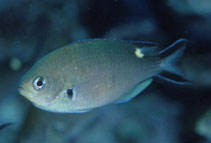
|
Azurina atrilobata (Gill, 1862) Scissortail damselfish |

|
|
photo by
Allen, G.R. |
| Family: | Pomacentridae (Damselfishes), subfamily: Chrominae | |||
| Max. size: | 13.4 cm TL (male/unsexed) | |||
| Environment: | reef-associated; marine; depth range 6 - 80 m, non-migratory | |||
| Distribution: | Eastern Pacific: northern Gulf of California to northern Peru, including the Galapagos and Cocos islands. | |||
| Diagnosis: | Dorsal spines (total): 12-12; Dorsal soft rays (total): 12-13; Anal spines: 2-2; Anal soft rays: 10-12. Brown with a prominent black spot on the base of the pectoral fin. Fins with thin light blue or white margin. | |||
| Biology: | Adults inhabit coral or rocky reefs (Ref. 9334). They aggregate in large numbers in open water above reefs and feed on zooplankton. Not strongly territorial as other damselfishes in the area. They become almost invisible in the darkness of deep water except for its brilliant post-dorsal white spot which gives the illusion of glowing in the dark. Oviparous, distinct pairing during breeding (Ref. 205). Eggs are demersal and adhere to the substrate (Ref. 205). Males guard and aerate the eggs (Ref. 205). | |||
| IUCN Red List Status: | Least Concern (LC); Date assessed: 27 May 2007 Ref. (130435) | |||
| Threat to humans: | harmless | |||
| Country info: |
|
|||